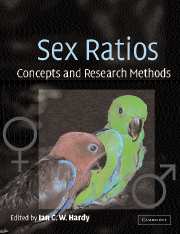Book contents
- Frontmatter
- Contents
- List of contributors
- Preface and acknowledgements
- Part 1 Sex ratio theory
- Part 2 Statistical analysis of sex ratio data
- Part 3 Genetics of sex ratio and sex determination
- Chapter 7 Sex-determining mechanisms in vertebrates
- Chapter 8 Sex determination in invertebrates
- Chapter 9 Sex ratio distorters and their detection
- Part 4 Animal sex ratios under different life-histories
- Part 5 Sex ratios in plants and protozoa
- Part 6 Applications of sex ratios
- Index
- References
Chapter 9 - Sex ratio distorters and their detection
Published online by Cambridge University Press: 06 August 2009
- Frontmatter
- Contents
- List of contributors
- Preface and acknowledgements
- Part 1 Sex ratio theory
- Part 2 Statistical analysis of sex ratio data
- Part 3 Genetics of sex ratio and sex determination
- Chapter 7 Sex-determining mechanisms in vertebrates
- Chapter 8 Sex determination in invertebrates
- Chapter 9 Sex ratio distorters and their detection
- Part 4 Animal sex ratios under different life-histories
- Part 5 Sex ratios in plants and protozoa
- Part 6 Applications of sex ratios
- Index
- References
Summary
Summary
Sex ratio distorters (SRDs) are heritable elements that modify the sex ratio of their host to promote their own transmission. In this chapter we examine various theories relating to the evolutionary importance of SRDs, give an overview of the various classes of SRDs and methods of how to discover them in the field, and outline areas of current contention, and thus future work in relation to their incidence and importance. Sex ratio distorters include organelles, heritable bacteria and eukaryotes, B chromosomes and meiotic-drive sex chromosomes. A high proportion of arthropod species that have been studied in detail harbour SRDs. They are important in host evolution because they influence fundamental population dynamic processes, manipulate sex-determining mechanisms of their host and may contribute to genetic isolation between host populations. If SRDs are parasitic, selection may promote the spread of host genes to prevent SRD action and transmission. Unusual sex ratio phenotypes in the field may indicate SRDs. This should be followed by genetic analysis of sex ratio phenotypes of isofemale lines. If micro-organisms are suspected, they can be identified molecularly with specific polymerase chain reaction (PCR) primer pairs and sequence analysis.
Introduction
What are sex ratio distorters (SRDs)? SRDs are broadly defined as those heritable elements that modify the sex ratio of their host to promote their own transmission, often at a cost to the inclusive fitness of the individual bearing them.
- Type
- Chapter
- Information
- Sex RatiosConcepts and Research Methods, pp. 195 - 216Publisher: Cambridge University PressPrint publication year: 2002
References
- 27
- Cited by



